Introduction
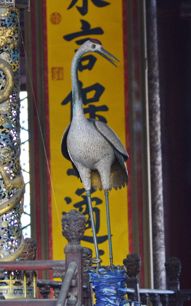 “At a recent trip to China I was impressed by the frequent use of birds in the history of China. The classical example is the cloisonné enamel (porcelain/ceramic pottery) crane figurines that adorn the throne of the emperor in the Forbidden City (see the image). The crane symbolises longevity (the long neck, a long life span) and auspiciousness which the emperor valued. The crane also represents a soaring spirit, health, and happiness. There are many references to birds in ancient drawings and artwork and contemporary artists continue to mimic these ancient craftsmen.
“At a recent trip to China I was impressed by the frequent use of birds in the history of China. The classical example is the cloisonné enamel (porcelain/ceramic pottery) crane figurines that adorn the throne of the emperor in the Forbidden City (see the image). The crane symbolises longevity (the long neck, a long life span) and auspiciousness which the emperor valued. The crane also represents a soaring spirit, health, and happiness. There are many references to birds in ancient drawings and artwork and contemporary artists continue to mimic these ancient craftsmen.
.
.
.
.
Red-crowned Crane adorning the Emperor’s throne at Forbidden City (rignt)
“One day, while having lunch (a Peking duck!), our excellent guide Mr. Peter Bo, knowing my interest in birds, was kind enough to point out and explain the historical use of birds on the uniforms of civil servants. Birds were used as a ‘ranking of seniority’ system and this was elaborately displayed on the walls of the restaurant we were at, allowing me to get some images.
Cloisonné enamel bowl with bird images (left); Phoenix-Dragon Motif in Empress Chambers at Forbidden City (right)
Historical Background on the use of Rank Badges in the Chinese Civil Service
“Rank badges have been worn in China since before the 14th Century. Initially worn by the emperor and then extended to the royal family and officers of the court. The emperor wore a five-clawed dragon and the empress phoenix, both mythical creatures symbolising strength, beauty and divine rule. From the Ming dynasty (1368-1644) the emperor awarded badges with creatures to court officials as signs of imperial favour. This was continued in the Qing dynasty (1644-1911) where there was further standardisation and increased bureaucracy with rigorous examinations introduced into the civil service. Birds then came to be used to denote various civil ranks, and predatory animals the military ranks. Rank badges continued to be used until the end of imperial rule.
“The use of a ‘bird ranking system’ is an imaginative and artistic scheme, better than the ‘pips’ or ‘stars’ given to today’s officers. It showed the value placed on animals and the connection the people had with nature.
Design and Location of Rank Badges
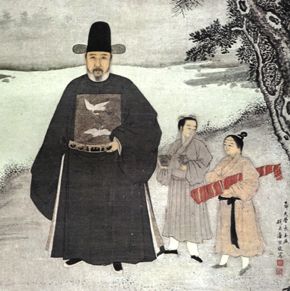 “The rank badges underwent some change over time. Initially woven into the chest and back of silk robes during the Ming dynasty, they became small squares sewn on to the court robe in the Qing dynasty. By the mid 1700s the emperor ruled that officials wear a dark, front-opening surcoat called ‘bufu’ (‘robe with a patch’). The drawing of the bird was placed on the breast plate and the back of the uniform. The front badge is divided into two pieces and sewed to the two sides of the front to accommodate the opening of the surcoat.
“The rank badges underwent some change over time. Initially woven into the chest and back of silk robes during the Ming dynasty, they became small squares sewn on to the court robe in the Qing dynasty. By the mid 1700s the emperor ruled that officials wear a dark, front-opening surcoat called ‘bufu’ (‘robe with a patch’). The drawing of the bird was placed on the breast plate and the back of the uniform. The front badge is divided into two pieces and sewed to the two sides of the front to accommodate the opening of the surcoat.
Ming Dynasty portrait of Chinese official Jiang Shunfu (1453–1504). The rank badge on his chest shows cranes indicating he was a civil official of the first rank. Original Image © Nanjing Museum. This image is in public domain at: LINK.
Choice of Bird for Rank Badges in the Chinese Civil Service
“There were nine civil ranks (important number in Chinese culture), each represented by a different bird. I suspect that the choice of the bird to determine rank was heavily influenced by the cultural outlook of the time. See images and description below. Images were taken with my long lens in a dark restaurant and I avoided flash so as not to disturb the other customers. This made images difficult to capture as I was too near and flash would not be useful due to glass covering the cloth plates. The rendering here is also not the original for the Qing dynasty period and some artistic liberty must be given. The restaurant also had the order of the birds mixed up. Hence I had to do quite some ‘research’ to identify the bird from the art work and may have got it wrong. I value opinions if I have made a mistaken identity. Internet searches for the original rank badges (on sale as antiques) also show much variation and difficulty in bird identification.
“In addition to artistic variation, problems with bird identification also result from attempts to ‘fool’ the common person by disguising a rank badge of a lower rank as that of a higher one. One common example is to make a 9th ranking Paradise Flycatcher look like a 5th rank Silver Pheasant. There were always enough identification marks to the discerning individual to see the real status.
“There were 9 ranks based on the value placed on the bird. The lowest rank was a Paradise Flycatcher and the highest rank was, not unexpectedly, the Crane. In between, from lowest to highest, were the Quail, Duck, Egret, Pheasant, Goose, Peacock and Pheasant.
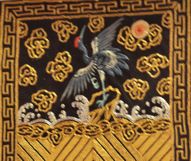
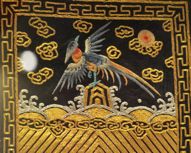
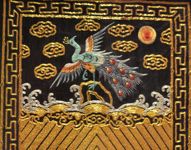
[Left tp right: Manchurian Crane (Red-crowned Crane Grus japonensis), Rank 1, Meaning: Longevity and wisdom; Golden Pheasant (Chinese Pheasant Chrysolophus pictus), Rank 2, Meaning: Courage; Peacock (Green Peafowl Pavo muticus), Rank 3, Meaning: Beauty, protection and holiness.]

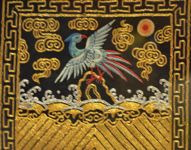
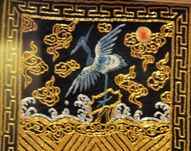
[Left to right: Wild Goose (uncertain about species as images come in white, shades of grey and brown. There are at least 12 geese in China. Could be the Swan Goose, Anser cygnoides), Rank 4, Meaning: Loyalty; Silver Pheasant (Lophura nycthemera); Rank 5, Meaning: Beauty and good fortune; Lesser Egret (Colours vary from white to grey in various images, so either the Little Egret, Egretta garzetta or Pacific Reef Egret Egretta sacra or Intermediate Egret Mesophoyx intermedia), Rank 6, Meaning: Happiness.]
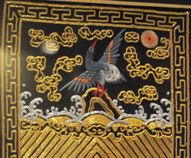
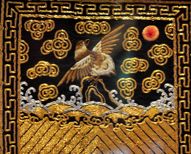

[Left to right: Mandarin Duck (Mandarin Duck (Aix galericulata), Rank 7, Meaning: Loyalty; Quail (unsure which one, possibly the Japanese Quail (Coturnix japonica), Rank 8, Meaning: Courage; Paradise Flycatcher (Asian Paradise-flycatcher Terpsiphone paradisi), Rank 9, Meaning: Longevity and good fortune.]
Impact of Rank Badges on Other Countries
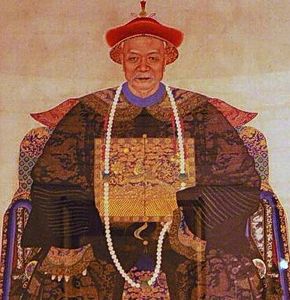
“The Chinese bird rank badges influenced neighbouring countries and trade partners. This included Hong Kong, Korea, Vietnam, Tibet and even Malaysia. To some there were pretty robes and gifts, to others (e.g. Vietnam) they copied not just the robes but the entire system behind it. In historical Malaya the Kapitan Cina (heads of the Chinese community) followed the Qing officials in dress and lifestyle. It is hard to find images but there is an example of Kapitan China Chung Keng Kwee (1827-1901) leader of Hakka-speaking Hai San society in Malaya (right).
[Original Image © Pinang Peranakan Mansion (also known as the Baba Nyonya Museum and the Kapitan Chung Keng Kwee Museum, Penang, Malaysia).]
Use of Rank Badges in the Chinese Military Service
“It is also meaningful to note that animals were also used to denote rank in the military service. Here they used nine animals, mainly predatory. Starting with the Sea Horse (horse that travels over waves) and moving up in rank progressively to the Rhinoceros (2 levels), Panther, Bear, Tiger, Leopard, Lion and ending with the Qilin (mythical hoofed Chinese chimerical creature).
Conclusion
“The use of birds and other animals in the daily life of the civil and military service may have marked a healthy respect for animals at the time. It could also indicate that society valued certain attributes in animals, be it beauty, strength or agility. In our time, in the magnificent city of Beijing, we noted that many of the locals appreciate their parks and nature. As the people of China become more environmentally conscious/active and bird watching grows, I would expect a resurgence in the value of birds in their culture.”
Dato’ Dr Amar-Singh HSS
Ipoh, Malaysia
October 2012
Copyright Note: All images were taken by and copyright the author, except for two images in open source which are specifically indicated with copyright information.
References:
1. Pacific Asia Museum – Rank and Style Dressing in Imperial China (excellent reference) http://www.pacificasiamuseum.org/rankandstyle/base.stm
2. Textile Museum: http://www.textilemuseum.org/totm/buziindex.htm


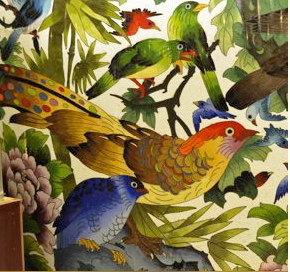
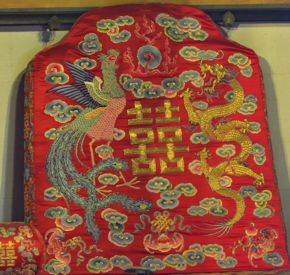







6 Responses
Dr Amar, that was excellent research; enjoyed reading your explanation on the relationship of bird images and humans. Thanks for sharing.
I too wanted to say that this was quite interesting. How people have seen and interacted with birds in history gives us a deeper understanding of both people and birds.
Dear Dr. Amar,
What a lovely article this is. It demonstrated not just the artistic skills of the embroiders and other skillful workers of the Ming/Qing dynasty, but also your skillful write-up and research on the topic.
Thanks for pointing me to this (from the BES Yahoo Group). Bureaucracy is well documented in Chinese history and a huge part of Chinese culture, and it’s very interesting to see how it ties in with art and even birds here. I found an amusing article in the December 1979 Sarasota Herald-Tribune on a Westerner’s account of modern day bureaucratic China (link here – http://news.google.com/newspapers?nid=1755&dat=19791201&id=dzweAAAAIBAJ&sjid=Ir8EAAAAIBAJ&pg=6792,239161 )… seems that even though many feudal traditions have been done away with, at the heart of it all, not much has changed since the old days!
Greetings from Carolina! I’m bored to tears at work so I decided to browse your website on my iphone during lunch break. I enjoy the info you provide here and can’t wait to take a look
when I get home. I’m surprised at how fast your blog loaded on my mobile .. I’m not even using WIFI, just 3G .
. Anyways, superb site!
Great web site you have got here.. It’s hard to find high quality writing like yours nowadays.
I truly appreciate individuals like you! Take
care!!